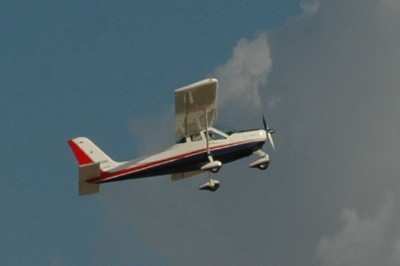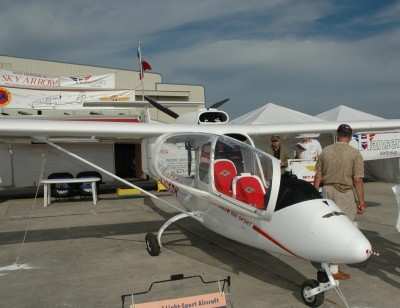Lessons Learned Include Funding, Aircraft Variety
by ANN Correspondent Chris Esposito
Yesterday, ANN reported on
Chesapeake Sport Pilot's start-up experience, as well as the
background of the owners, Tim and Al Adelman. Today, we continue
the story with more on the wisdom the owners gained in forming an
LSA flight school.

As with most successful flight schools, maintenance was an
expense the Adelmans had already taken into consideration. Tim and
Al found the maintenance costs associated with the 100 hour
inspections and engine reserve fund tacked on almost $20 an hour to
their total operating cost for each aircraft. Fuel was inexpensive
due to the powerplants and limited horsepower of the LSA aircraft,
and Chesapeake's owners found the average fuel burn to be about 4.5
gallons per hour. For fuel alone, the cost to fly each aircraft is
almost $20 an hour.
Another important aspect of the school's financial structure is
payroll. As a CFI, Tim understood how important it was to pay
instructors well, and the school's CFIs are the most well-paid
flight instructors in the area. They are paid per hour of flight,
so they are free to create their own schedules and only work when
they want to. The staff also has the extra benefit of being able to
rent aircraft for close to the operating cost.

Tim cautioned against underestimating costs for insurance and
financing, as well as for any airport fees you might incur.
Insurance for each ship runs around $6,000 per year, and general
liability insurance for the premises is close to $1,200 a year. The
cost for financing the aircraft depends on the purchase price, but
is usually in the $1,000 per month range. Airport tie downs and
airport fees can rack up another $300 a month, and of course it is
recommended to have money saved for miscellaneous expenses.
Accounting and keeping track of students should not be taken
lightly, as TSA audits are likely for new schools. Tim says to make
sure students' folders have all the information necessary for TSA
audits, as this is easy to overlook. Chesapeake Sport Pilot
features an online credit card system for transactions, and online
scheduling that also lets students view their accounts to see how
much money they have left. The school restricts online scheduling
for students during certain times of the day, but allows renters
with a rating to have access to the aircraft at any time, and
provides the keys for after-hours flights.

The Adelmans mentioned that a pro forma (a model of future
finances) is a necessity, as it will allow you to form goals such
as flying f40 hours a month. By calculating operational costs and
expenses, one can estimate potential income. Tailoring your
financial plan to the intended consumer is also important. This is
what led Chesapeake Sport Pilot to obtain the Sport Cruiser and
Tecnam.
Some of the school's students liked the "fighter pilot feel" of
the Sky Arrow, but others expressed interest in a sleek-looking
aircraft for short hops and pleasure flying, which led to the
Adelmans adding a Sport Cruiser to their fleet. Others wanted
something similar to a 172, which pointed the school towards a
Tecnam. Experienced pilots looking for something fun to rent wanted
advanced avionics to play with, and in response to this Chesapeake
ordered another Sport Cruiser with a Dynon avionics package.

Finding students for the flight school came naturally, as the
school's previous research showed a tremendous demand for a light
sport school. "We have not paid for a single advertisement yet."
says Tim.
Using online forums, word of mouth, and websites such as www.sportpilot.org,
Tim was able to generate traffic and the flight school expanded
quickly. While the school was only formed in February of 2007,
Chesapeake already has 60 students, and a three week wait for new
students.
The school is now flying each plane 70-90 hours a month, and
will soon have four active light sport aircraft. "We're adding two
more airplanes later this month and a fifth one this fall." says Al
Adelman. New students are also coming in at the rate of five per
week, and at start-up they were adding two new students per
day.

The Adelmans plan to sell their fleet of sport aircraft as they
age and replace them with factory-new planes. The two owners see
opportunity to flip the airplanes in the used-LSA market.
For those who are interested in starting their own light sport
schools, the Adelmans said their initial start-up cost was $25,000
for a one-aircraft school, and would be about $41,000 for a
two-aircraft school. The owners recommend a much larger reserve
than this for unforeseen expenses, and also recommend buying two of
the same aircraft so there is some redundancy in the training fleet
should one plane go down for maintenance.
Chesapeake Sport Pilot is an example of a flight school that was
not simply started on a whim, but thoroughly researched by its
owners. The school is so busy students are waiting three weeks to
get started, and the school is continuing to grow. "All of our
expectations have been met." says Al.
 ANN's Daily Aero-Linx (04.13.24)
ANN's Daily Aero-Linx (04.13.24) ANN's Daily Aero-Term (04.13.24): Beyond Visual Line Of Sight (BVLOS)
ANN's Daily Aero-Term (04.13.24): Beyond Visual Line Of Sight (BVLOS) Airborne 04.09.24: SnF24!, Piper-DeltaHawk!, Fisher Update, Junkers
Airborne 04.09.24: SnF24!, Piper-DeltaHawk!, Fisher Update, Junkers Aero-News: Quote of the Day (04.14.24)
Aero-News: Quote of the Day (04.14.24) ANN's Daily Aero-Term (04.14.24): Maximum Authorized Altitude
ANN's Daily Aero-Term (04.14.24): Maximum Authorized Altitude







